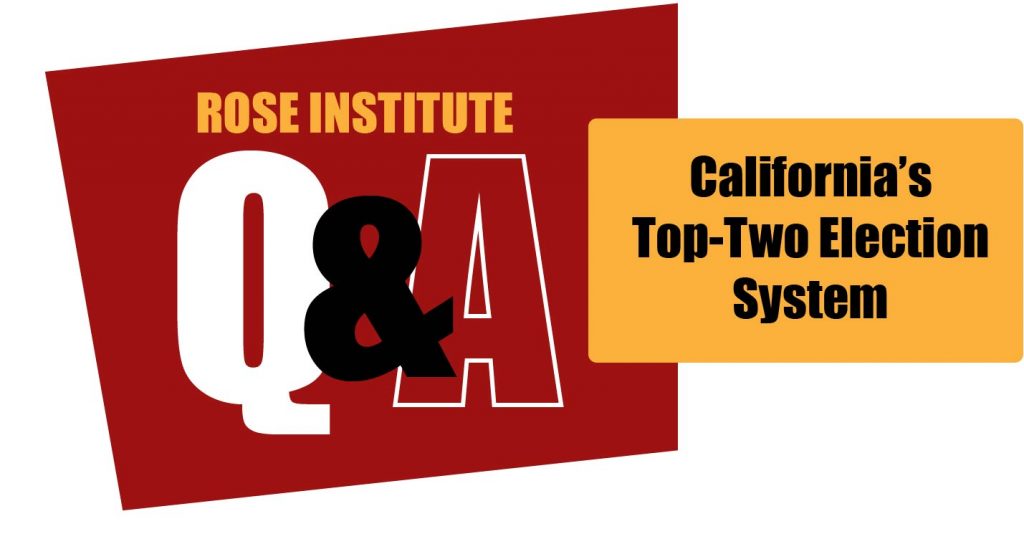
Download Full Report
Rose Institute of State & Local Government
Claremont McKenna College
Prepared by: Andrew Sinclair, Assistant Professor of Government | asinclair@cmc.edu
With the assistance of: Catherine Murphy, CMC ’24; Bryn Miller, CMC ’19; Ian O’Grady, CMC ’15
June 1, 2022
Overview
In 2010, California voters, frustrated with gridlock and dysfunction in state and national politics, passed Proposition 14. This measure, implemented in 2012, adopted a top-two system for elections for the state legislature, U.S. Congress, and most statewide offices. These elections use simple rules: any voter can vote for any candidate in the primary and the two candidates with the most votes advance to the general election.
Despite a decade of experience and the simplicity of the election rules, journalists, policymakers, scholars, and interested citizens still have many questions about what the top-two system does and how it has affected the state’s politics. This inaugural edition of the Rose Institute’s Questions and Answers series addresses these issues.
This Overview offers a brief outline and summary of the Q and A. The four sections of the Q and A group questions thematically, beginning with providing detail and context about the new system, moving on to describing what has already happened, and then addressing the more complicated questions about political effects. The final section provides even more information about some of the more significant issues. Despite the growing body of valuable scholarly literature, referenced extensively in the Q and A, not all of these questions have easy or undisputed answers.
Section I: The Top-Two System
Proposition 14 created a nonpartisan top-two election system. Confusion about the top-two begins with its name: although often called the “top-two primary,” these procedures affect both primary and general elections in California.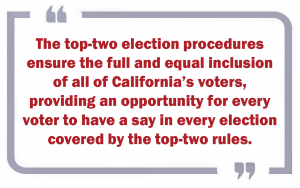
California’s top-two system has three essential characteristics, setting it apart from prior procedures used in California, the rules used to elect California offices unaffected by Proposition 14, and related systems in other states.
- It is nonpartisan in participation. Voters can participate in the primary election and choose any candidate for any office covered by the top-two, regardless of party affiliation.
- It is nonpartisan in competition. All candidates compete against each other in the primary to be the two finalists in the general election, and some contests will have general elections between candidates of the same party.
- It is not nonpartisan in information. Unlike some other nonpartisan election systems, California’s top-two system still provides partisan information on the ballot. Voters know the party affiliation preferences of the candidates (listed next to their names). Parties also can make official endorsements.
The top-two election procedures ensure the full and equal inclusion of all of California’s voters, providing an opportunity for every voter to have a say in every election covered by the top-two rules.
The top-two provides greater freedom of choice not only for independent voters but also for registered partisans. Twenty-nine percent of California’s voters are not registered with the Democratic Party or the Republican Party. The top-two system allows these voters to participate meaningfully in elections without facing additional procedural requirements and without requiring the assent of the major parties. More subtly, the top-two also allows Democrats and Republicans greater opportunities to express their views. For example, in 2022, the Los Angeles Times endorsed a Democrat (Gavin Newsom) for governor and a Republican (Lanhee Chen) for California controller. Under the old partisan primary procedures, not a single voter in California could have expressed such a preference on the primary ballot.
Section II: Election Outcomes
Some outcomes are readily observable: what types of general elections take place, how competitive they are, and how many people vote.
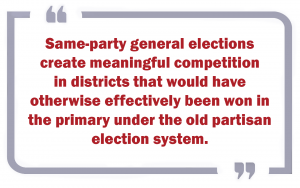 Election Types
Election Types
Although most general elections in California still feature a Democrat facing a Republican, same-party general elections do occur. The same-party elections are more common in open seats and in places typically lacking significant cross-party competition.
Same-party general elections create meaningful competition in districts that would have otherwise effectively been won in the primary under the old partisan election system. The potential for same-party general elections creates a new kind of electoral risk for all candidates in partisan safe seats. All officeholders know they could, at some point, have to win a majority of the voters in their community without relying on their party label alone.
Turnout and Participation
Although one clear claim supporting Proposition 14 was that it would increase turnout, participation is surprisingly complicated to assess. Participation was highly variable statewide across years with the top-two procedure, from a low of 25.2% in 2014 to a high of 47.7% in 2016. These statistics largely miss the point, though. In districts that have same-party general elections in otherwise safe seats, the decisive contest has moved from the primary election to the general election. The participation comparison really ought to be between the general election under the top-two rules and the primary election under an alternative partisan system.
To briefly illustrate this point: in the 2010 partisan primary election that renominated Democratic U.S. Senator Barbara Boxer, there were just over 2.4 million votes cast in the Democratic primary, which she won handily. Surprising no one, Boxer would go on to win the general election, as did every other statewide Democrat. The 2018 election—another midterm, but of the top-two era–sent two Democrats to the general election ballot for U.S. Senate. Some Republicans declined to vote in this Democrat-on-Democrat race; nevertheless, just over 11 million Californians cast ballots in a 54%-46% general election contest between longtime Democratic incumbent Dianne Feinstein and challenger Kevin de León. Comparing the 2010 midterm Democratic primary to the 2018 midterm general election—both of which selected which Democrat was going to be in the U.S. Senate—shows an increase in participation of more than four times the number of votes.
Addressing Concerns
Several concerns exist about the top-two election system.
One fear is that split support among the majority party’s candidates will result in a same-party general election featuring only candidates of the weaker party, shutting a majority party out of a seat it otherwise ought to win. This risk is real but small. In the several hundred California top-two elections in the past decade, there is only one clear example where the majority party was shut out of the general election—the election in Congressional District 31 in 2012.
Another concern is that, in general elections between candidates of the same party, some voters without candidates of their own party on the ballot (sometimes called “orphans”) will skip voting in those contests. This behavior is now well-documented in political science research. This concern, like many of the other issues related to the top-two, is a discussion about trade-offs. The abstention of some orphaned voters in same-party elections is the cost of removing partisan barriers to participation in the primary and the potential participatory and political value of competitive same-party general elections in safe seats.
Another criticism of the top-two system is that third-party candidates do not often earn enough votes to make the general election ballot. Although there are no formal restrictions, Democratic and Republican primary candidates typically appeal to more voters. This does not change the fact, though, that third parties were not successful before the top-two either, nor very successful in other states. In some ways, new or third parties have unrealized opportunities in the top-two system, as well: for the right party at the right time, the nonpartisan structure could actually help a new or alternative party compete by locally replacing one of the major parties. This has not happened yet, though.
Other concerns about the top-two are addressed throughout the Q and A.
Section III: Impact on Politics
Proposition 14 promised to help produce “less partisan” and “more practical” elected officials. The proponents sought to change not only who won, but also how politics worked in California. 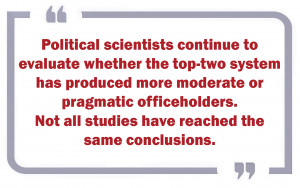
Political scientists continue to evaluate whether the top-two system has produced more moderate or pragmatic officeholders. Not all studies have reached the same conclusions. These studies raise some very interesting questions, including what it means for someone to be “less partisan” and “more practical;” how such concepts can be measured and observed; and how changes in outcomes can be attributed to one particular change in the state’s political institutions.
California politics have changed since the passage of Proposition 14. In the Public Policy Institute of California (PPIC) statewide survey at the time Proposition 14 was adopted, only 9% of California voters approved of the state legislature; by the 2020 election, this had risen to 49% (and remained at that level in the May 2022 PPIC survey). The yearly crisis over the state budget, a sign of the previous era’s gridlock and a reason for the passage of Proposition 14, has largely disappeared. Furthermore, voters tend to report liking the top-two system.
Nevertheless, there are substantial reasons to be cautious in interpreting such findings or attributing results to Proposition 14.
The top-two was only one of many changes introduced at approximately the same time in California politics—including adopting a redistricting commission (Proposition 11, 2008; Proposition 20, 2010), ending the supermajority vote requirement for the state budget (Proposition 25, 2010), changing term limits (Proposition 28, 2012), and improving the state’s financial position by increasing taxes (Proposition 30, 2012). All of these changes were implemented in the context of a changing economy, a declining state Republican Party, and significant events like the Covid-19 pandemic. The top-two had been crafted, in part, to help obtain the necessary compromise in the state legislature to get a budget passed. Sorting out what the contribution was from any particular reform or change can be difficult.
Section IV: Additional Details
To some extent, this Q and A is a plea for the interested public and opinion-makers to remember that American politics involves a complex array of institutions and participants. Short and simple answers are hard to come by. The final section follows up on the earlier questions, providing more detail about the “shut-out” risk, turnout, and moderation. It also provides additional information about competing reforms including the “Final-Four” system in Alaska and proposals for a “Final-Five” primary (with ranked-choice-voting). It concludes by highlighting the unique attributes of the 2022 and 2024 election cycles.
Evaluating Reform
This edition of Questions and Answers responds to many questions – save one: which electoral institutions are best? Electoral institutions—the rules we use to conduct elections—are important. They turn abstract concepts of democracy as “rule by the people” into the reality of handing power to some people and not others. Altering election procedures can change who wins, the incentives winners face while in office, and even which democratic values a society embraces. For those reasons, parties, advocates, elected officials, and citizens have battled over American election procedures for generations; the passage of Proposition 14 in California in 2010 was an extension of debates begun in the state at least a century before, in the Progressive Era.
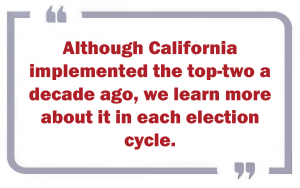 Yet, all institutional choices come with trade-offs; scholars have known for a long time that there is no such thing as an inarguably perfect election system, and which trade-offs make sense may depend on the individual values of the person making the assessment. For that reason, this Q and A does not endorse or oppose any particular election procedure.
Yet, all institutional choices come with trade-offs; scholars have known for a long time that there is no such thing as an inarguably perfect election system, and which trade-offs make sense may depend on the individual values of the person making the assessment. For that reason, this Q and A does not endorse or oppose any particular election procedure.
The questions explored in this edition of Questions and Answers are intended to help readers form their own judgments about the top-two system and the trade-offs involved in using it.
In evaluating the top-two, there are also two distinct approaches. Should it be judged on the basis of what it does, or whether it has met the objectives of its advocates? These are not the same standards, and may not yield the same answers. For example, the top-two could provide real benefits, and be better in some way than the alternatives, while still falling short of what advocates had promised or hoped to achieve. Both ways of evaluating the top-two are intellectually defensible but represent different lines of inquiry.
A thoughtful evaluation of the nonpartisan top-two election system also acknowledges that new elections happen every two years. The answers to some of the questions in this Q and A may change in light of new facts and new circumstances. Although California implemented the top-two a decade ago, we learn more about it in each election cycle.
Questions and Answers: The Top-Two
These are the questions addressed in this edition of Questions and Answers.
I: DESCRIBING THE TOP-TWO ELECTION SYSTEM
How does the top-two election system differ from traditional partisan elections?
How does the top-two election system differ from the “blanket primary” we used to have in California?
How are local elections different from the elections controlled by Proposition 14?
Does California still use partisan ballots for presidential primaries?
II: LOOKING AT ELECTION OUTCOMES
What are the pathways for the top-two system to change how politics works?
How often, and under what circumstances, do same-party general elections occur?
Do same-party elections promote competitiveness?
Can a party be “shut out” of an election it ought to win?
Do independent or third-party candidates often win elections?
Has voter turnout increased?
III: ASSESSING THE IMPACT ON POLITICS
Why is it so hard to get a simple answer about the effect of the top-two?
What do voters think of these kinds of election systems?
Did the top-two produce more moderate or collaborative legislators?
What other impacts might there be beyond moderation?
Did the top-two system make the Republican Party uncompetitive in California?
IV: ADDITIONAL DETAILS
What happened in CD31 in 2012?
How should we count turnout?
What does moderation mean?
How does top-two compare to final-four or final-five?
What should we watch for in 2022 and 2024?
Acknowledgments
Thanks to: Catherine Murphy, Bryn Miller, Ian O’Grady, Kenneth P. Miller, R. Michael Alvarez, Christian R. Grose, Betsy Sinclair, Bipasa Nadon, and Marionette Moore for advice and assistance.
